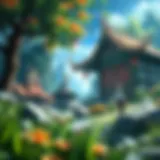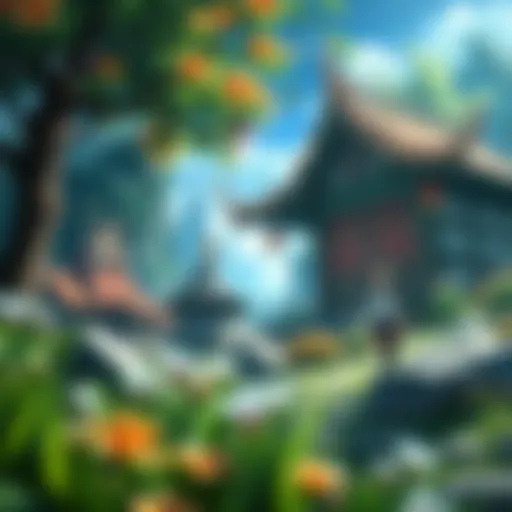Chronological Journey Through the Dragon Ball Saga


Intro
The Dragon Ball saga stands as one of the most influential franchises in the anime and manga world. Created by Akira Toriyama, it has transcended cultural boundaries, capturing the hearts of audiences around the globe. The journey of its characters, such as Goku and Vegeta, offers more than mere entertainment; it reflects themes of friendship, perseverance, and growth.
Understanding the timeline and the sequence of events in this sprawling universe can be overwhelming for both newcomers and seasoned fans. That's where this guide comes in. By dissecting key moments, character developments, and the series' evolution, readers will gain a clearer view of how the Dragon Ball universe is woven together.
Industry Insights
Monkeying around with trends, the landscape of anime has transformed significantly over the years. Today, Dragon Ball continues to remain a bright star in the industry. The franchise's recent resurgence in popularity has breathed new life into conversations surrounding the genre. Notably, the introduction of Dragon Ball Super has rekindled interest, drawing in both nostalgic fans and fresh faces eager to join the adventure.
Latest Trends in Anime Industry
The anime market is witnessing several shifts:
- Expanding Genres: While shounen dominates, niche genres are gaining traction.
- Diversification of Storytelling: Complex narratives are now more common, bringing depth beyond action.
- Increased Accessibility: Streaming platforms offer new ways to consume series, making it easier for fans everywhere.
"Anime as a medium is rapidly evolving, and franchises like Dragon Ball are at the forefront of these changes."
Behind-the-Scenes of Popular Shows
Delving into the production side unveils many fascinating stories. The animated series brought to life by Toei Animation faced numerous challenges throughout its creation. For example, the adaptation of the manga into an animated format involved tight deadlines and balancing the intricate details that fans desire. This blend of artistry and technical precision continues to set high standards across the industry.
Reviews & Recommendations
When diving deeper into the Dragon Ball saga, various series within the franchise stand out for their unique contributions. For instance, Dragon Ball Z is famous for its high-stakes battles and character transformations, while Dragon Ball Super expands on the universe’s lore, pushing boundaries further.
Must-Watch Anime Recommendations
While exploring Dragon Ball is essential, several other series can capture your interest:
- One Piece: Known for its extensive lore and world-building.
- My Hero Academia: Offers a fresh take on heroes with engaging character arcs.
- Attack on Titan: Dark and intense, this series provides gripping storytelling.
News & Updates
As Dragon Ball continues to be relevant, new developments keep the excitement alive. The franchise's latest announcements often spark discussions:
- New Game Releases: Video games based on the franchise, like Dragon Ball Z: Kakarot, reveal the story through immersive gameplay.
- Movie Announcements: Recent films have reignited fan enthusiasm, bringing renewed focus on beloved characters.
Feature Articles
Analyzing iconic characters within the Dragon Ball universe yields rich insights into their complexities. Goku’s unyielding spirit and Vegeta’s pride offer an exploration of growth and redemption. Future articles will delve deeper into these narratives and how they resonate within pop culture, showing their lasting impact.
Upcoming Insights
Expect detailed comparisons between the different series in the franchise, highlighting how they integrate various themes, as well as character development. Moreover, the influence of gaming technology will also be explored, showing how interactive media has shaped fan experiences over the years.
Foreword to Dragon Ball
The Dragon Ball series stands as a monumental pillar in the realm of anime and manga, carving out a special niche for itself since its inception. Its allure transcends mere entertainment, delving into rich storytelling and character development. In this section, we’ll unpack the significance of the series' beginnings, providing insight into what plunges fans into this vast universe. This introduction isn’t just about Son Goku or the thrilling quests. It’s about understanding the very essence of what makes Dragon Ball a captivating phenomenon in pop culture.
Origins of the Series
Dragon Ball traces its roots back to the manga created by Akira Toriyama, first serialized in Weekly Shōnen Jump in 1984. Inspired by the classic Chinese novel Journey to the West, Toriyama infused the narrative with modern sensibilities and a quirky charm that resonated with the youth of that era.
The protagonist, Son Goku, was introduced as a naive and cheerful child with incredible martial arts skills and a tail, symbolizing his Saiyan heritage. Goku's journey, which kick-starts with his quest for the mythical Dragon Balls, propels readers into a world filled with fantastical elements.
With its unique blend of humor, fights, and adventure, Dragon Ball showcased Toriyama's distinctive art style, which is still celebrated today. The series didn't just capture the attention of fans; it laid the groundwork for shonen manga that came after, influencing various creators and genres both in Japan and worldwide.
Cultural Impact and Legacy
The cultural imprint of Dragon Ball cannot be overstated. It has morphed into a global phenomenon with dedicated fanbases in numerous countries. Merchandising, adaptations, and spinoffs have enriched the franchise, solidifying its presence in the mainstream. Characters like Vegeta, Piccolo, and many others have become icons in their own right, often represented in various media—from video games to blockbuster films.
"The essence of Dragon Ball lies not only in thrilling battles but also in the enduring friendships and rivalries it depicts."
Its influence has been felt in diverse areas, notably:
- Anime and Manga: Many series cite Dragon Ball as a primary inspiration. Elements like transforming into a powerful form or the quest for magical artifacts have become staples in the genre.
- Gaming: Multiple video games, such as the Dragon Ball Xenoverse series, have helped keep interest alive among younger fans, melding gameplay with the familiar stories and characters.
- Community Engagement: This saga fosters vibrant communities online, evident on platforms like Reddit and Facebook, where fans passionately discuss theories and share fan art.
In summation, the introduction of Dragon Ball marks not just the start of a captivating story but also the inception of a cultural phenomenon that continues to evolve. It serves as a gateway for newcomers while maintaining its roots in the hearts of long-time fans.
Dragon Ball: The Beginning
The initiation of the Dragon Ball saga marks a significant turning point in manga and anime history. This segment lays the groundwork for the entire series, giving fans not just characters to root for, but also a richly woven universe filled with lore, adventure, and growth. Understanding the inception of Dragon Ball is crucial if one intends to grasp the complex character evolutions and overarching themes present throughout the saga.
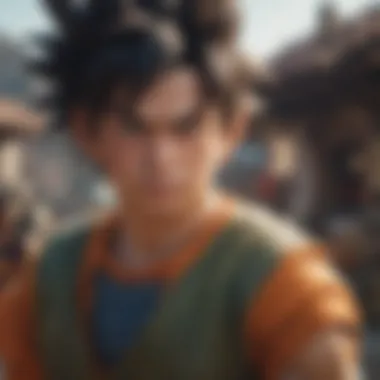

Prolusion of Son Goku
Son Goku is not merely the protagonist; he embodies the very essence of what the series represents. Introduced as a young boy with a monkey tail, Goku’s naivety and boundless curiosity are immediately apparent. He isn’t just a fighter; he's a symbol of the quest for self-discovery. Born from a race known as the Saiyans, he is initially unaware of his heritage.
This contrast between innocence and latent power is a recurring theme, leading viewers down a path where strength is often juxtaposed with morality. Goku’s introduction pulls audiences into a tale where not only battles matter, but also the friendships forged along the way.
The Quest for the Dragon Balls
The Dragon Balls serve as the backbone of the narrative, propelling both plot and character arcs forward. These mystical orbs, which grant wishes when gathered, initiate Goku’s adventure and introduce a myriad of characters drawn by the same desire—to possess the power of the Dragon Balls. This quest sets up fundamental relationships and themes that resonate throughout the series.
The desire for the Dragon Balls highlights human traits such as ambition, greed, and camaraderie. Characters like Bulma, who initially seeks the Dragon Balls for a personal wish, become integral to Goku’s journey as allies. The quest metaphorically illustrates themes of unity and diversity, as different individuals from various backgrounds come together for a common purpose.
Key Characters and Their Development
The early chapters of Dragon Ball present a colorful cast that brings depth to the storyline. Every character introduced serves a purpose that contributes to Goku’s growth and the narrative's evolution.
- Bulma: A genius inventor, her intelligence and resourcefulness complement Goku's raw power and unrefined instincts.
- Master Roshi: The wise mentor figure for Goku, instilling not only martial arts techniques but also essential life lessons on humility and balance.
- Yamcha: Initially an antagonist, he unfolds into Goku's ally, showcasing character development through friendship and rivalry.
In contrast to many series that only focus on a hero’s rise, Dragon Ball skillfully explores the complexities of each character’s journey. These evolving dynamics give the series its richness, paving the way for intricate themes of rivalry, growth, and redemption. Ligting the way for Goku's evolution from an innocent child into a revered hero is a tapestry woven through the individual experiences of those around him.
"Dragon Ball isn’t just a story; it’s a celebration of growth, friendship, and the enduring spirit of adventure."
These foundational elements serve not merely as a backdrop but as the driving force behind the entire saga, making the beginning of Dragon Ball an essential point of exploration for any fan or newcomer.
Dragon Ball Z: Expansion of the Universe
The transition from Dragon Ball to Dragon Ball Z marked a pivotal shift in storytelling and character depth within the franchise. This metamorphosis not only broadened the narrative's scope but also enriched the emotional landscape, delivering a complex tapestry of character conflicts and transformations.
One of the critical aspects of Dragon Ball Z is its expansion beyond the origins established in the first series. Here, the stakes escalate dramatically, introducing formidable foes and delving deeper into the lore of Saiyans and their warrior culture. This not only rekindles interest among long-time fans but also attracts a new audience.
The introduction of new themes, such as sacrifice, identity, and the enduring struggle between good and evil, creates a multifaceted experience. The series dives into various character arcs that mirror real-life challenges, allowing viewers to connect with their journeys. The essence of Dragon Ball Z lies in its ability to craft a narrative that's both fantastical yet relatable—grappling with issues that resonate on a personal level.
The Arrival of Raditz
The Arrival of Raditz serves as the monumental entry point for Dragon Ball Z. Raditz, Son Goku's long-lost brother, brings with him a sense of aforementioned responsibility and urgency that was largely absent in the previous series. His presence not only unravels the mystery surrounding Goku's origins but also introduces the Saiyan race, expanding the universe dramatically.
This moment acts as a clarion call for Goku. Here, he grapples with the realization that he is part of a more significant cosmic conflict, engendering themes of family loyalty and duty. Raditz’s challenge is a catalyst propelling Goku into a broader struggle that tests not just his strength but his moral compass as well.
"The arrival of Raditz opens a Pandora's box of potential, setting the stage for battles that are not just about personal glory but about saving the very fabric of Earth itself."
The Saiyan Saga
As Dragon Ball Z unfolds, the Saiyan Saga champions a diverse array of storytelling elements. This arc is critical not only for its action but for how it establishes character motivations and development. Here, the stakes are staggeringly high: Goku is faced with the grim reality of losing loved ones and his home to an enemy that’s fueled by revenge and ambition.
Vegeta and Nappa introduce an intimidating challenge, pushing the Z fighters to their limits and revealing layers of Goku’s tenacity and an iconic rivalry that would shape the series moving forward. The battles are intense, showcasing Goku's growth as he must transcend his limits while simultaneously dealing with his Saiyan heritage.
The goals and aspirations of characters evolve, bringing richness to their arcs. Gohan, Goku’s son, emerges as an unexpected hero, showcasing bravery reminiscent of his father.
The Frieza Saga
The Frieza Saga defines what epic storytelling means in the vast realm of anime. The saga is situated on the planet Namek and encapsulates the climactic power struggle between Goku and Frieza, pushing the boundaries of creativity in the series. Frieza, known for his sheer ruthlessness and ambition to obtain the Dragon Balls, transforms the narrative into a relentless drive for survival.
This arc also addresses the consequences of unchecked power and the morality that comes with it. Goku's transformation into a Super Saiyan introduces an iconic moment in anime history, representing the culmination of struggle and the fight against oppression. It's a stark reminder that power can corrupt, but resilience can ignite change.
The emotional resonance is palpable—loss, betrayal, and vengeance fuel the fires of conflict, while moments of camaraderie provide much-needed balance. The epic battles interlaced with personal sacrifices encapsulate why Dragon Ball Z remains influential, fueling discussions, theories, and connections among its audience.
In essence, the expansion of the Dragon Ball universe through Dragon Ball Z transforms the foundational elements, crafting a vibrant and intricate saga of growth, power, and persistence that continues to inspire both fans and newcomers.
Dragon Ball Z: Continued Adventures
As we delve into the continued adventures of Dragon Ball Z, it becomes clear that this phase of the saga is pivotal in expanding character arcs and introducing more complex narratives. The series not only deepens the lore but also enhances the emotional stakes for fans. The allure of these arcs lies in their intricate storytelling and character development, providing a fertile ground for analysis and discussion.
The Cell Saga
The Cell Saga marks a turning point in the narrative arc of Dragon Ball Z. Introduced through the mysterious and formidable Cell, this arc brings an amalgamation of horror and thrill. Cell, a bio-engineered entity, represents not just a physical threat but a philosophical one, challenging Goku and his friends to confront their own limitations and moral dilemmas. The introduction of the infamous "Cell Games" poses profound questions about justice and redemption. The stakes escalate dramatically when characters such as Gohan emerge, showcasing growth that deviates from the typical path of sheer power.
This saga also focuses on the theme of inheritance—both in terms of abilities and ideologies. Goku’s decision to train his son Gohan to surpass him might reflect the age-old battle between parental expectations and individual aspirations. Gohan's ultimate transformation into Super Saiyan 2 is not just a power-up; it's a symbol of resilience and hope against the backdrop of despair.
- Key Elements of the Cell Saga:
- The introduction of Cell as a multi-form villain.
- The emotional culmination at the Cell Games, highlighting Gohan's growth.
- Exploration of ethical dilemmas surrounding power and its consequences.
Dragon Ball Super: A New Era
The release of Dragon Ball Super marked a significant turning point in the storied legacy of the Dragon Ball franchise. It revitalized the series for both die-hard fans and a new generation of viewers. This installment reintroduced classic themes, alongside fresh elements that kept the core excitement alive. The narrative explored essential aspects like the vast Dragon Ball universe and the introduction of powerful new characters, which not only expanded the lore but also deepened the emotional stakes for viewers.
Chronological Placement within the Dragon Ball Series
Dragon Ball Super fits snugly in the timeline between the events of Dragon Ball Z and the epilogue that briefly occurs at the end of the last saga. This chronological placement is crucial, as it bridges the gap left after the Majin Buu Saga. It picks up right after Goku defeats Kid Buu, showcasing the lives of characters as they adapt to a new world devoid of their greatest threats. By filling this gap, it creates seamless continuity, allowing fans to witness the unfolding challenges that arise.
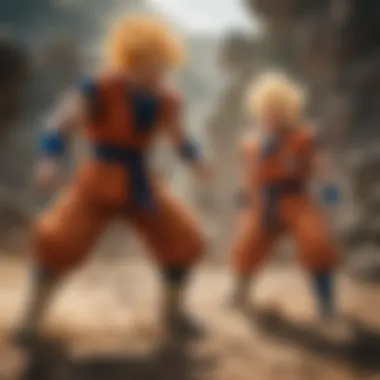

Moreover, introducing the Gods of Destruction and Angels adds layers to the existing hierarchy, prompting characters and viewers alike to consider the ramifications of power on a cosmic scale.
- Key Points of Chronological Importance:
- Continuity of character arcs, especially Goku and Vegeta's growth.
- Exploration of universal conflicts that affect multiple realms within the series.
- Introduction of new powerful opponents that challenge established characters.
By grounding itself within the timeline, Dragon Ball Super reminds fans of the threads that bind these stories, deepening engagement with character arcs and unfolding narratives.
The Universe Tournament Arc
The Tournament of Power stands as one of the high points of Dragon Ball Super, igniting excitement with its multifaceted battles and tactical confrontations. This arc pits Universe 7 against other universes in a fight for survival, creating a high-stakes environment where only the strongest warriors may prevail. Here, every encounter is layered with the thrill of competition, but also the underlying theme of companionship. The stakes couldn't be higher: lose, and not just your universe, but all its existence is erased.
During the Tournament, the camaraderie among characters shines through, especially in moments where rivals set aside differences for a common cause. One could argue this arc captures the essence of true team spirit.
"Friendship is like a good tournament - helps you grow stronger together while keeping the competition fiery."
Prominent features of the Universe Tournament Arc include:
- Diverse Combatants: Each universe brings forth unique fighters, each with their own abilities and styles, enriching the overall combat experience.
- Strategic Depth: The arc invites a chess-like strategy, enticing viewers to think beyond brute strength, showcasing clever tactics that often turn the tide in battles.
- Character Development: Significant growth for characters like Frieza and Android 17, who surprise not just their opponents but often themselves, shattering past limitations.
This arc ultimately redefines the narrative, balancing the weight of epic battles with personal stories, reinforcing the series’ enduring appeal to a diverse audience. Dragon Ball Super not only advances the plot but also opens the door for more complex character explorations and future storylines.
Dragon Ball Movies and Specials
The Dragon Ball franchise isn't merely limited to its episodic series; it has also expanded its universe through movies and special episodes. These films hold significant importance in the overall narrative, offering fans a chance to explore alternative storylines, character developments, and unique themes that sometimes stray from the main timeline. Many viewers find joy in diving into these films as they often present high-stakes scenarios that are not explored in depth in the series, allowing for richer character interactions or breath-taking battles. Given the sheer volume of content produced, understanding these films can enhance one’s appreciation of the franchise. They act as an extension of the core stories, while some, notably the canonical films, serve as essential pillars in the story arch of the characters.
Overview of Canonical Films
When discussing the Dragon Ball movies, it’s vital to differentiate between canonical and non-canonical films. Canonical films are those that directly tie into the official timeline established by the anime series. For instance, Dragon Ball Z: Battle of Gods is hailed for reinvigorating the franchise, introducing significant elements like the God forms and the mighty Beerus, the God of Destruction. Similarly, Dragon Ball Z: Resurrection 'F' reintroduces Frieza with a fresh perspective that revitalizes the character and offers nostalgia for long-time fans.
These movies often explore key themes and have substantial character development. Dragon Ball Super: Broly, for example, not only expands upon Broly's character, aligning him with the contemporary narrative but also dives into the Saiyan culture. Fans received an aesthetically pleasing resurgence of action sequences, along with an emotional depth that might not be present in regular series episodes.
- Dragon Ball Z: Battle of Gods
- Dragon Ball Z: Resurrection 'F'
- Dragon Ball Super: Broly
These films serve as a refreshing reminder of the storytelling prowess that Akira Toriyama, the creator, shows. They also highlight various character dynamics, acting as a bridge connecting viewer’s experiences across different arcs.
Non-Canon Films Worth Noting
On the flip side, non-canon films, while not officially part of the Dragon Ball timeline, still offer a delightful mix of entertainment and nostalgia. They often push the limits of creativity within the established universe. Films such as Dragon Ball Z: The Tree of Might or Dragon Ball Z: Bardock – The Father of Goku feature stories that, despite not being considered official lore, engage audiences and shed light on characters in unique ways.
These movies allow for imaginative possibilities. In Bardock – The Father of Goku, viewers are treated to a glimpse of Bardock’s life and his struggle against Frieza, ultimately providing context that enhances the viewing experience of the series. Although they might not fit perfectly into the lore, they are certainly worth the watch, especially for those eager to delve deeper into ancillary storylines.
Notable Non-Canon Films:
- Dragon Ball Z: The Tree of Might
- Dragon Ball Z: Bardock – The Father of Goku
- Dragon Ball: Mystical Adventure
These films can arguably hold significant value as they cultivate understanding and appreciation while resonating with the emotional undercurrents present throughout the series.
By examining both the canonical and non-canonical films, fans can grasp a complete picture of the Dragon Ball universe. Movies and specials lay down an expansive canvas upon which dramatic stories unfold, inviting fans to relish characters and their journeys beyond the traditional episodic format.
Understanding the Dragon Ball Filler Content
Filler content often prompts discussions among fans, and within the vast universe of Dragon Ball, this topic warrants particular attention. Filler refers to episodes or arcs not adapted from the original manga, added primarily to allow the source material more time to develop. Understanding filler is paramount in navigating the series, as it becomes both an integral and contentious aspect of the viewing experience. Knowing what constitutes filler helps fans decide how to approach the series, whether watching everything for a complete picture or focusing mainly on the core storyline.
The significance of discussing filler in this article lies in its impact on pacing and character development. In some instances, filler episodes grant viewers a unique glance at characters' lives, adding an extra layer of depth. For example, some slice-of-life episodes surrounding Son Goku and his family illustrate their daily lives and relationships. While some might argue fillers detract from the main story arc, they can also enrich the universe by showcasing less intense moments that flesh out the characters' humanity.
What Constitutes Filler?
When assessing what qualifies as filler within the Dragon Ball series, it’s crucial to recognize specific characteristics. Generally, filler episodes fall into one of the following categories:
- Original Content: These are episodes not derived from Akira Toriyama’s manga. They either divert from the main plot, introduce new characters, or create wholly original arcs.
- Extended Scenes: Some fillers simply elaborate on established scenes, providing backstory or additional context to existing events.
- Character-Specific Stories: Often, fillers may focus on a single character’s journey, providing insight into their motivations or aspirations, without affecting the primary storyline.
Recognizing these traits allows fans to differentiate between canon and non-canon material effectively, ultimately leading to a more tailored viewing experience.
Filler Episodes in the Context of the Narrative
In considering filler episodes within the Dragon Ball series, it’s essential to examine their broader context. Some fillers provide narrative relief amidst intense story arcs, serving as comic interludes. For example, the two-part saga regarding the World Tournament allows characters such as Mr. Satan and Videl to shine, but doesn't directly influence the main battles or conflicts.
Another example can be seen in the various tournament arcs spread throughout Dragon Ball Z. These filler episodes often serve as a breather, allowing both characters and viewers to regroup before facing high-stakes situations.
While viewing patterns differ greatly across fans, those who opt to skip fillers might miss pivotal character growth. Vegeta’s complexities, for instance, can be further explored when watching filler episodes, especially ones that spotlight his rivalry with Goku.
Ultimately, filler content stands as a double-edged sword within the narrative context. It can be seen as pacing issues, but it also broadens the world-building and deepens audience connection with characters by highlighting less tumultuous aspects of their lives.
In essence, understanding filler content elevates the viewing experience, granting fans insight and depth within the Dragon Ball universe.
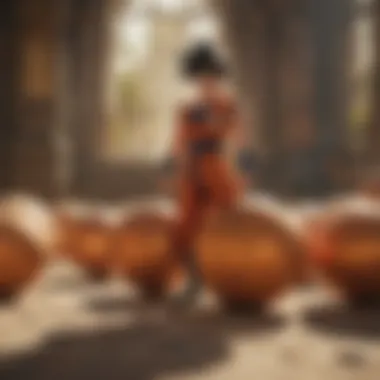

In summary, while filler may seem trivial to some, it plays a functional role within a larger framework that emphasizes character relationships and narrative pacing. Through an informed exploration of filler, viewers can gain a well-rounded appreciation of this iconic series.
Character Arcs in Dragon Ball
Exploring character arcs in the Dragon Ball series is vital to understanding the emotional core and evolving dynamics within the narrative. These arcs offer fans rich layers of complexity, showcasing not just battles and techniques, but profound personal growth and transformational journeys. This discussion shines a light on how each character’s journey resonates with audiences on various levels, providing a way for spectators to connect deeply with the characters and their struggles. Characters are not just vague illustrations of strength; they embody themes of resilience, redemption, and personal discovery.
Son Goku: The Hero’s Journey
Son Goku, the protagonist, represents the archetypal hero whose path is full of challenges and growth. From his early days as a naive child living in isolation to becoming a stalwart defender of Earth, Goku’s arc is a testament to perseverance and continual improvement. His relentless pursuit of greater strength symbolizes the joy of self-discovery and ambition.
During the course of the series, Goku’s transformation unveils his core values, such as friendship and what it means to be truly human—after all, he is Saiyan by blood but much more by heart. Each battle he faces serves not only as a means to protect his loved ones but also as an opportunity for introspection. The swelling stakes and formidable foes push him beyond his limits, and audiences witness a character constantly striving to push his boundaries.
Goku’s heart is interwoven with themes of compassion and forgiveness. He often chooses not to eliminate his opponents outright, instead giving them chances for redemption. This characteristic reflects a nurturing spirit, emphasizing that strength lies not merely in power, but in the courage to uplift others.
"Goku’s ability to see the good in others, even the most vicious of enemies, reaffirms the notion that redemption is always possible."
In essence, Goku encapsulates an ideal—the journey is as significant as the destination.
Vegeta: From Rivalry to Redemption
Vegeta’s character arc is a poignant tale of redemption that contrasts sharply with Goku’s path. Initially introduced as a self-absorbed prince of the Saiyan race, fiercely proud and unscrupulous, Vegeta's transformation over the series marks one of the most profound character evolutions in the franchise.
His rivalry with Goku is compelling; it serves as both motivation and a mirror reflecting his own insecurities. Unlike Goku, whose motivations often stem from a desire for personal growth and enjoyment, Vegeta is driven by pride and a yearning for acknowledgment. This yearning forces him to confront his darkest aspects and encourages a gradual shift from villainy to a more nuanced role as a hero.
As the series unfolds, Vegeta’s arc embraces themes of loyalty, family, and vulnerability. The moment he acknowledges his love for his family, particularly for Bulma and Trunks, a major shift occurs. He begins to redefine strength, recognizing that true power comes not only from skill within battle but from protecting those he holds dear.
Though he often grapples with feelings of inadequacy when compared to Goku’s effortless achievements, Vegeta’s struggles are ultimately what shape him into a multifaceted character. His journey illustrates that embracing one's flaws can lead to authentic growth.
These two characters, Goku and Vegeta, serve as distinct yet complementary representations of the series’ broader themes. Each of their journeys reflects the different ways individuals confront adversity and strive for personal betterment.
Themes and Motifs in Dragon Ball
The Dragon Ball saga stands out not only for its dynamic battles and vibrant characters but also for the rich tapestry of themes woven throughout its narrative. The thematic exploration is a cornerstone of the series, compelling the audience to reflect on the underlying messages that resonate beyond the screen. From the bonds of friendship to the relentless pursuit of growth, these motifs define not just the characters' journeys, but also the audience's emotional investment in their stories.
The themes of Dragon Ball serve as a reminder of the universal struggles faced by individuals—each struggle echoing the realities of life itself. Recognizing these recurring ideas enhances the viewer's understanding of character motivations and the interconnectedness of their journeys. Whether it’s the camaraderie fostered during the fiercest battles or the internal competition that drives personal development, each element is meticulously crafted to reflect significant life lessons.
Friendship and Companionship
At the heart of the Dragon Ball saga lies the notion of friendship and companionship. As the main characters traverse vast worlds, defeat formidable foes, and face insurmountable odds, the friendships they forge become a vital source of strength. This theme is exemplified through the relationships among characters like Son Goku, Krillin, and Bulma. Their bonds illustrate the significance of support systems—showing that even the mightiest warrior can’t go it alone.
Each character displays loyalty and sacrifice, highlighting that true strength often comes from unity. The classic moments of teamwork, such as during the Frieza Saga, where diverse personalities come together to combat a common threat, underscore the value of collaboration.
- Notable Friendships:
- Goku and Vegeta: Rivals turned allies, showcasing the evolution of their relationship over time.
- Goku and Piccolo: A transformation from enemies to partners, emphasizing redemption and mutual respect.
"Strength lies in differences, not in similarities" – Stephen R. Covey.
This sentiment rings true in Dragon Ball, where the diversity of characters enhances both the narrative and the emotional stakes. Genuine connection inspires growth, showing viewers that personal battles become more manageable when shared with others.
Competition and Growth
The theme of competition is another pivotal aspect of Dragon Ball, weaving itself into the very fabric of each saga. Competition acts as a catalyst for growth, driving characters to surpass their limits and discover new potentials. This relentless pursuit of power is not merely about brute strength; it's about character evolution and the willingness to embrace challenges.
Goku’s unyielding desire to become the strongest fighter sets the tone for numerous arcs. Each opponent he faces serves not as just a foe but as a challenge that propels him to new heights. Even the fierce rivalry with Vegeta transitions from animosity to respect, illustrating how competition can foster camaraderie and mutual improvement.
- Key Competitions and Their Impact:
- World Martial Arts Tournament: A showcase of skills, emphasizing fair play and honor.
- The Universe Tournament: A broader spectrum where teams from different universes compete, further expanding the narrative's scope.
In essence, competition in Dragon Ball symbolizes personal growth and self-discovery. It’s a reminder that through challenges, characters reveal their true selves. By pushing boundaries and embracing struggles, both the characters and viewers can partake in a transformative journey toward achieving their own greatness.
The Future of the Dragon Ball Franchise
As we look towards the horizon, the future of the Dragon Ball franchise appears both bright and full of potential. This beloved series has etched itself into the annals of pop culture, providing audiences with memorable characters, thrilling battles, and philosophical undertones. The significance of discussing its future lies in understanding how it can adapt, evolve, and continue to resonate with fans old and new.
With the expanding universe of Dragon Ball, there's an eagerness to see what new narratives and character developments await. A fresh storyline can reinvigorate interest, pulling in a younger audience while catering to the nostalgia of long-time fans. Importantly, ongoing developments in various media—from animated series and films to video games—can enhance engagement and create broader conversations within the fandom.
Upcoming Projects and Developments
In recent years, several projects have been announced, hinting at the direction the franchise might be heading.
- New Anime Series: Rumblings about a potential revival or continuation of the anime, following the success of Dragon Ball Super, have been floating around. Fans speculate about how Goku and his allies could face new threats or revisit older ones with a modern twist.
- Spin-off Manga and Novels: Akira Toriyama’s universe is rich with possibilities. New stories exploring secondary characters or alternative timelines have potential to draw interest while providing deeper insights into the already established lore.
- Video Games: Titles like Dragon Ball Z: Kakarot have shown that gaming can give fans new experiences by retelling stories in interactive ways. Upcoming releases might incorporate virtual reality or augmented reality to pull players deeper into the Dragon Ball world.
Community and Fan Engagement
The heart of the Dragon Ball saga lies in its community. Fan engagement plays a crucial role in nurturing the franchise's future.
- Conventions and Events: Anime conventions often feature Dragon Ball panels, where fans gather to discuss theories, share fan art, or even meet voice actors. These gatherings foster a sense of belonging among fans.
- Online Platforms: Sites like Reddit and Facebook have groups where enthusiasts share creative interpretations and analyses of characters and arcs. Such platforms can further set trends in the fan community, guiding official releases and content.
- Fan Projects: Many fans take it upon themselves to create fan art, animations, or even fan-made episodes. This not only showcases their love for the series but can also attract new viewers and players, reminding the industry that the world of Dragon Ball thrives on passion and creativity.
"Fan engagement is key to keeping the franchise relevant. The community has the power to shape the narrative and influence future projects."
